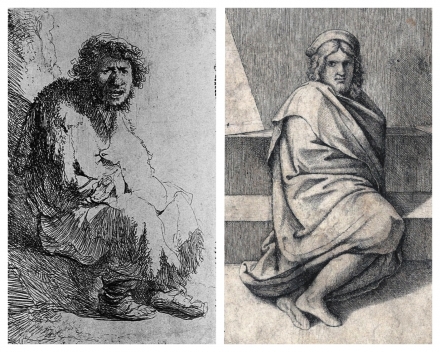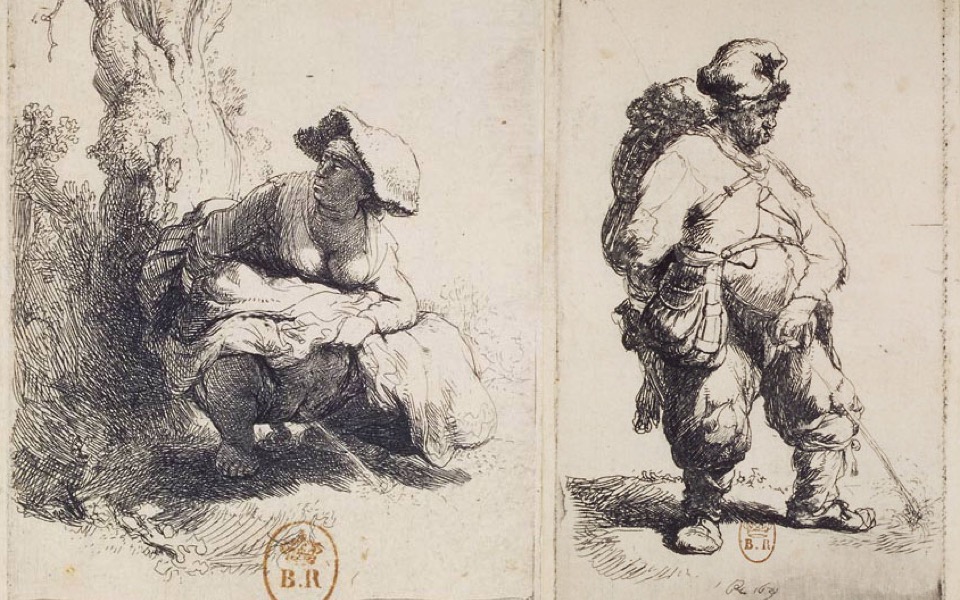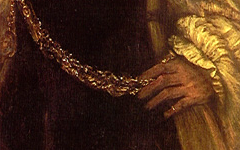Rembrandt’s Self-portrait as A Beggar Seated on a Bank (1630)
The unusual self-portrait of Rembrandt dressed as a beggar (below left) upends, or so it has been said, what we know about seventeenth-century social attitudes.1 Why would Rembrandt present himself destitute? Peter Schatborn opined that the "etching gives the impression that Rembrandt wanted to make a portrait of himself as a beggar, but this is not so. In fact, he transferred the expression of despair that he had depicted [in an earlier self-portrait of his head alone]....to the beggar."2 I have trouble even understanding what that means. Clifford Ackley, a Curator at the Museum of Fine Arts, Boston for more than forty years, writes: "This extraordinary bit of role-playing need not necessarily be taken as signifying a Christ-like identification on Rembrandt's part with the beggar's lot [actually, it should be] but should perhaps be viewed - Rembrandt had a robust sense of visual humor - as a good, if inside, joke. The 24-year old artist was not yet fully established and could use some financial assistance!"3 Unfortunately that comment reveals a complete misunderstanding of both art and the artistic mind. Let's be more serious.

L: Rembrandt, Beggar Seated on a Bank (1630) Etching on paper. Only State.
R: Callot, Standing Beggar (c.1620-23) Etching. Rijksmuseum, Amsterdam.
Click image to enlarge.
Rembrandt's most obvious inspiration has long been known (near left): a print of a standing beggar with a similar shoulder and hand by Jacques Callot (c.1592-1635).4 It tells us nothing about Rembrandt's meaning, only that he used a beggar to draw a beggar. Why? Rembrandt was more inventive than that. Unknown is that Rembrandt's original source is of completely different subject matter, an engraving Callot had also used to create his beggar. Knowing that, Rembrandt referred to the Callot too to emphasize his unity with other artists and thus the unchanging truth of art's wisdom. Only by knowing the real source can the viewer make sense of either image, Callot's or Rembrandt's.
Click next thumbnail to continue

L: Rembrandt, Beggar Seated on a Bank (1630)
R: Raimondi, Portrait of Raphael (c.1510-20) inverted. Engraving on paper
Click image to enlarge.
Each was inspired by Marcantonio Raimondi's rarely-noted portrait of Raphael (near left), a print I show was used by both the young Manet in his first masterpiece and by the young Picasso in his Blue Period paintings of syphilitic women.5 Rembrandt was young too and all their figures, poor and distressed, represent artists. See how Rembrandt and Raphael sit on a flat surface, wrapped in fabric, their heads turned slightly towards the viewer, the underside of one foot visible and a diagonal line at upper left. Rembrandt is not only "Callot" but "Raphael" too in a studio. That is also why the beggar, like Callot's too, has the iconic frown of an artist.6
Click next thumbnail to continue

L: Rembrandt, Beggar Seated on a Bank (1630) Inverted.
R: Rembrandt, Portrait of Gerard de Lairesse (mid-1660's) Oil on canvas. Metropolitan Museum of Art, New York.
Click image to enlarge.
Three decades later Rembrandt based a portrait of the syphylitic art theorist and painter Gerard de Lairesse (near left) on his earlier self-portrait (inverted for comparison). Note the bent arm and form of fabric below it. Both have a thumb separated from the fingers to suggest a palette-hand with the thumb through the palette's hole. Rembrandt's other arm (his brush-hand) is inside his cloak from which we can infer that he is "painting" himself, his interior self. Inside we are all poor without material possessions and, like artists who struggle to create, we suffer too. Legend had it as well that Raphael was sick when Raimondi portrayed him.
Click next thumbnail to continue

L: Rembrandt, Portrait of Gerard de Lairesse (mid-1660's)
R: Detail of Raimondi's Portrait of Raphael (c.1510-20)
Click image to enlarge.
Once again, Rembrandt used his original source in the later portrait. The folded paper echoes the V-shaped shadow to the left of Raphael's thigh and the bare table behind resembles not only the bench on which Raphael sits but the perspective of his palette too cropped at the left edge of Raimondi's print. De Lairesse, the ill and suffering art theorist, is based on the "sick" Raphael and Rembrandt's self-portrait as a suffering beggar just as Picasso's women are sick too.7 Once again, the unity of true artists and art's tradition is stressed by all of them.

Top: Detail of Rembrandt's Beggar Seated on a Bank (1630)
Bottom: Detail of Raimondi's Portrait of Raphael (c.1510-20)
Click image to enlarge.
We must not forget to look at the eyes, one of an artist's two most important body parts. Note how Rembrandt, along with many other artists, gives his face one eye open, one squinting and almost closed.8 Raphael (below) has one eye light, the other dark. They represent the two modes of artistic perception: normally an open eye for exterior vision and a closed one for insight. Here, however, the squinting eye might indicate exposure to the light and thus the exterior world while the fully open eye, given that the beggar is a mental image inside Rembrandt's mind, might be open for insight. Either way, the meaning is similar.
I hope this demonstrates that a scene described by some as almost inconsequential has a more profound and serious message. Besides, it shows how important source-hunting is, a tradition frowned on in academia. It is important because without knowing the true source, which may depict something completely different, one cannot know the meaning of the subsequent image because a form, even if changed into another object or figure, retains its original meaning in its new metamorphosis.
More Works by Rembrandt
Notes:
1. Ackley, Rembrandt's Journey. Painter. Draughtsman. Etcher. (Boston: Museum of Fine Arts) 2003, p. 91
2. Rembrandt the Printmaker (British Museum Press) 2001, pp. 93-4
3. Ackley, p. 91
4. Rembrandt the Printmaker, pp. 93-4
5. See online at EPPH: Abrahams, "Manet's Absinthe Drinker (1858-9)" and "Picasso's Harlequin (1901) and Blue Period."
6. See online at EPPH: Abrahams, "Ron Mueck's A Girl (2006)"
7. Sickness and fever are associated in shamanic traditions with spiritual transformation, the passage from one reality to another. A notable number of great artists in the Western tradition have portrayed themselves when sick including, in no particular order, Dürer, Poussin, Goya, Van Gogh, Kathe Köllwitz, Edvard Munch, Paula Modersohn-Becker, Egon Schiele, Frida Kahlo, Lucian Freud, Francis Bacon and possibly Caravaggio in his Self-portrait as Bacchus. It has been argued that the mystical epiphanies and out-of-body experiences described in the poetry of Emily Dickinson were linked to some unknown medical condition and the medications she took for it. The creative illnesses of both Freud and Jung are said to have provided them with insights and methods that would later constitute the foundational principles of the analytical schools. The Jungian school "later came to consider creative illness as being a kind of initiatory malady comparable to that of the shaman.” See for artists John Klein, Matisse Portraits (Yale University Press) 2001, p. 199; "Emily Dickinson: Sweeping Up the Heart", The Economist, August 20th, 2010, p. 67; for Freud and Jung, Jean D. Collins, “The Trickster and Creative Illness”, Gnosis 19, Spring 1991, pp. 27-31.
8. See the theme Outsight-Insight and the many examples within it by, at current count, 23 different artists from all centuries since the Renaissance.
Original Publication Date on EPPH: 07 Aug 2013. © Simon Abrahams. Articles on this site are the copyright of Simon Abrahams. To use copyrighted material in print or other media for purposes beyond 'fair use', you must obtain permission from the copyright owner. Websites may link to this page without permission (please do) but may not reproduce the material on their own site without crediting Simon Abrahams and EPPH.



